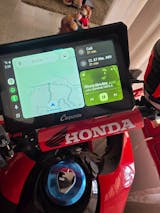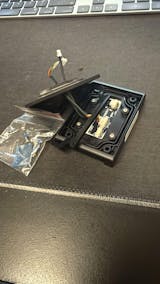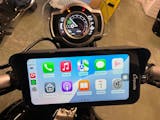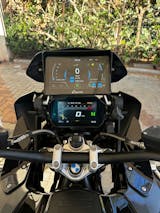CarPlay is an in-car system developed by Apple that integrates the main functions of the iPhone into the vehicle's native interface. With CarPlay, drivers can operate their iPhones directly on the vehicle's display, using Siri voice commands to send messages, make calls, listen to music, or use navigation.
There are three ways to install CarPlay in a car:
-
Using a CarPlay Adapter
-
Replacing Head Units
-
Installing an extra CarPlay Unit
Carplay Adapter
CarPlay adapters are devices that act as an interface between the car’s infotainment system and an iPhone, allowing the car to mimic the CarPlay interface through the existing audio system.
How to Install Carplay Adaptor on your car?
-
Skip regular Bluetooth & Wi-Fi connections between your car and phone.
-
Plug the adapter into the car's USB port.
-
Wait for the box system's boot page, then select the CarPlay to get the device name.
-
Turn on your phone's Bluetooth and WLAN, and select the box's Bluetooth name.
-
Pair your phone with the adapter via Bluetooth, then wait for Apple CarPlay to start.
-
Connect the adapter's AUX output to the car if needed.
-
Complete the initial setup (if needed), and access apps on CarPlay.
-
Now you can use CarPlay directly from your dashboard.
Pros and Cons
Pros:
Easy to Install: Most CarPlay adapters are plug-and-play, requiring minimal technical skills.
Cost-Effective: Adapters are generally less expensive than replacing the entire head unit.
Flexibility: They allow older cars to access modern technology without extensive modifications.
Cons:
Compatibility Issues: Not all adapters work seamlessly with every car and iPhone model, which can lead to connectivity or functionality issues.
Dependent on Phone’s Battery: If not using a wired connection, it can drain the phone’s battery faster.
Potential Quality Limitations: Audio and display quality might not match that of a native CarPlay system due to the limitations of the existing car's hardware.
Requires a built-in screen: The Carplay adapter limits its use to cars that already have a display interface.

Replacing Head Units for Cars
Head units involve stereo or infotainment system. To enable Carplay, we can swap them out with a new one that supports Apple CarPlay. These head units come with modern features including touchscreens, enhanced connectivity, and integrated navigation.
How to Replace Head Units to Enable Carplay?
-
Disconnect the battery by removing the negative terminal.
-
Remove dash panels around the existing head units with tools.
-
Unscrew and extract the head unit from the mounting bracket.
-
Connect the wiring harness adapters and other connections.
-
Slide the new head unit into the mounting bracket securely, ensuring it aligns with the dashboard aesthetics.
-
Test if the new head units work and secure the new one if it works.
-
Follow the instructions to set up CarPlay and configure any additional settings.
Safety Notice
Power Off: Detach the negative cable of the car's battery to prevent accidental current that could cause shorts or electric shocks. Then wait for a while to ensure all vehicle's power is disconnected before starting work.
Proper Tools: Use the appropriate tools for the installation. Improper tools can not only damage components but also cause injury to people.
Anti-Static Precautions: Take anti-static measures when handling electronic components, especially those connected to the vehicle's electronic system. Consider wearing an anti-static wristband, protective gloves, etc.
Follow Instructions: Follow the manufacturer's installation guide to ensure correct procedures and requirements are met. Incorrect installation can affect device performance or damage other parts of the vehicle.
Professional Advice: If unsure about your installation skills, it's best to consult a professional or seek expert advice before starting.
Pros and Cons
Pros:
Enhanced Features: New head units often come with upgraded audio and display quality, modern interfaces, and additional features like Bluetooth connectivity and HD Radio.
Full Integration: Offers a more integrated and seamless look and experience compared to using adapters.
Cons:
Cost: Replacing a head unit can be expensive, especially if professional installation is required.
Complexity of Installation: The installation process can be intricate and might affect the vehicle's warranty or existing wiring setup.
Compatibility: Not all new head units will fit every vehicle model, which can limit options for some cars.

Carplay Unit
The CarPlay unit is a dedicated wireless carplay screen designed to add Apple CarPlay functionality to vehicles that do not have it integrated natively or built-in head units. It allows drivers to access various CarPlay features such as navigation, music, calls, and messages directly through the touchscreen.
Let's take Carpuride W903 as the example, which has received numerous endorsements and recognition from collaborating YouTubers, ensuring its quality and service.
How to Install Carplay Unit?
-
Choose the right bracket and place the Carplay Unit on it.
-
Mount the bracket on the windshield or dashboard.
-
Connect the charger and pair your phone with the CarPlay Unit via Bluetooth.
-
Connect the other cables for front-facing dash cam and the rear one (if needed).
Advantages of Carplay Unit
High-Resolution Display: The Carpuride W903 features a high-definition display that provides a clear visual experience, making it easy to view navigation, media, and other applications.
Compatibility: This device is compatible with a wide range of vehicles without requiring the replacement of the original head unit, ensuring easy installation.
Wireless Connectivity: It supports wireless CarPlay and Android Auto, allowing users to connect their phones and use their functions without the hassle of cables, including playing music, navigation, calling, etc.
Voice Control: The device supports voice assistants such as Siri and Google Assistant, enabling users to operate it through voice commands, which enhances driving safety.
Versatility: In addition to CarPlay and Android Auto, the Carpuride W903 in car entertainment systems supports Bluetooth connectivity, FM transmission, USB, and AUX inputs, catering to various user needs.
Easy Installation: The device does not require a complicated installation process, allowing users to set it up easily without professional help.
How do I add a device to Apple CarPlay?
1. Ensure that your iPhone is compatible with CarPlay and that your car supports CarPlay.
2. Connect your iPhone to your car using a USB cable or via wireless CarPlay if your car supports it.
3. On your iPhone, go to "Settings" > "General" > "CarPlay."
4. Select your car from the available options.
5. Follow the on-screen instructions to complete the setup. Once set up, you can use CarPlay by connecting your iPhone to your car.
FAQ for Carplay Units
Can I add CarPlay / Android Auto on any existing car?
Yes, you can add CarPlay / Android Auto to most existing cars, and decide the way to add CarPlay / Android Auto based on your cars and exsiting infotainment system.
Using a CarPlay Adapter: This is a simple plug-and-play device that connects to your car's current infotainment system, enabling CarPlay functionality. Some adapters also come with Android Auto connection.
Replacing the Head Unit: You can replace your car’s original head unit with an aftermarket one that supports CarPlay. This often requires professional installation but provides a more integrated solution.
Installing an Extra CarPlay Unit: This option involves mounting an additional device that offers CarPlay features, usually on the dashboard. It doesn't replace your existing system but adds CarPlay capabilities.
Is it illegal to use a touch screen while driving?
The legality of using a Carplay touch screen while driving varies by country and region, please check and follow the specific traffic laws and regulations in your area before you use Carplay touch screen.
In many places, it is illegal to use a touch screen or any handheld device while driving due to safety concerns. Like in SA this only applies to P1, and in Queensland, it applies to P1 if you’re under 25. However, using hands-free or voice-activated features like CarPlay is typically allowed, as these methods reduce driver distraction.
What should I consider when selecting an in-car entertainment system?
Compatibility: Ensure the stereo is compatible with your car’s make, model, and your phone.
Screen Size and Resolution: Consider the size and resolution of the screen. Larger and higher resolution screens provide easier visibility and interaction.
Connectivity Options: Look for a stereo offering various connectivity options, including Bluetooth, USB ports, Wi-Fi, and FM transmission.
Audio Quality: Consider the audio output quality. Check the specifications for output power and whether it supports surround sound formats. Additional features like an equalizer, bass boost, or integration with premium sound systems can improve the audio experience.
Ease of Use: It should be available with intuitive and responsive interface. Physical buttons or knobs for volume and track control benefits ease of use.
Additional Features: Look for extra features that may be important to you, such as voice control, built-in GPS navigation, rear camera support for parking, or the ability to play DVDs and other media formats.
Price: Set a budget and consider the features you are getting for the price. Higher-priced models typically offer more features and better integration with advanced technologies.
Reviews and Brand Reputation: Finally, look up customer reviews and consider the brand's reputation for quality and warranty service. Reviews can provide real-world insights into the reliability and performance of the stereo screen.











